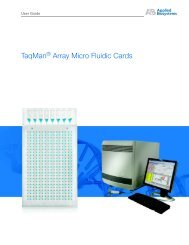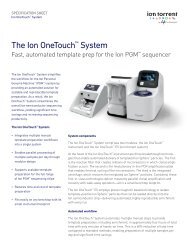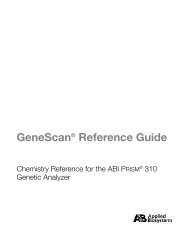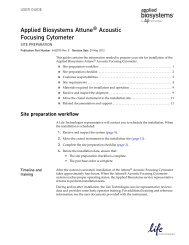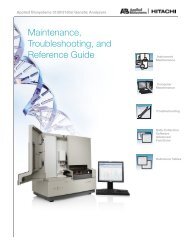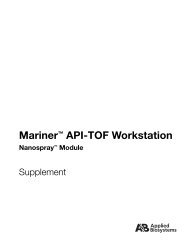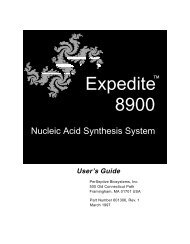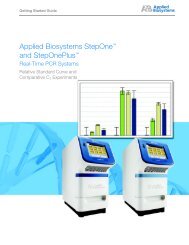3130/3130xl Genetic Analyzers Getting Started Guide, Rev - Applied ...
3130/3130xl Genetic Analyzers Getting Started Guide, Rev - Applied ...
3130/3130xl Genetic Analyzers Getting Started Guide, Rev - Applied ...
You also want an ePaper? Increase the reach of your titles
YUMPU automatically turns print PDFs into web optimized ePapers that Google loves.
Safety<br />
Chemical Waste Safety<br />
Chemical Waste Safety<br />
Chemical Waste<br />
Hazard<br />
Chemical Waste<br />
Safety <strong>Guide</strong>lines<br />
HAZARDOUS WASTE. Refer to Material Safety Data Sheets and<br />
local regulations for handling and disposal.<br />
CHEMICAL WASTE HAZARD. Wastes produced by <strong>Applied</strong><br />
Biosystems instruments are potentially hazardous and can cause injury, illness, or death.<br />
To minimize the hazards of chemical waste:<br />
Read and understand the Material Safety Data Sheets (MSDSs) provided by the<br />
manufacturers of the chemicals in the waste container before you store, handle, or<br />
dispose of chemical waste.<br />
Provide primary and secondary waste containers. (A primary waste container holds<br />
the immediate waste. A secondary container contains spills or leaks from the<br />
primary container. Both containers must be compatible with the waste material and<br />
meet federal, state, and local requirements for container storage.)<br />
Minimize contact with chemicals. Wear appropriate personal protective equipment<br />
when handling chemicals (for example, safety glasses, gloves, or protective<br />
clothing). For additional safety guidelines, consult the MSDS.<br />
Minimize the inhalation of chemicals. Do not leave chemical containers open. Use<br />
only with adequate ventilation (for example, fume hood). For additional safety<br />
guidelines, consult the MSDS.<br />
Handle chemical wastes in a fume hood.<br />
After emptying the waste container, seal it with the cap provided.<br />
Dispose of the contents of the waste tray and waste bottle in accordance with good<br />
laboratory practices and local, state/provincial, or national environmental and health<br />
regulations.<br />
Waste Disposal If potentially hazardous waste is generated when you operate the instrument, you must:<br />
Characterize (by analysis if necessary) the waste generated by the particular<br />
applications, reagents, and substrates used in your laboratory.<br />
Ensure the health and safety of all personnel in your laboratory.<br />
Ensure that the instrument waste is stored, transferred, transported, and disposed of<br />
according to all local, state/provincial, and/or national regulations.<br />
IMPORTANT! Radioactive or biohazardous materials may require special handling, and<br />
disposal limitations may apply.<br />
xx <strong>Applied</strong> Biosystems <strong>3130</strong>/<strong>3130</strong>xl <strong>Genetic</strong> <strong>Analyzers</strong> <strong>Getting</strong> <strong>Started</strong> <strong>Guide</strong><br />
DRAFT<br />
November 3, 2004 9:51 am, Safety_fm



